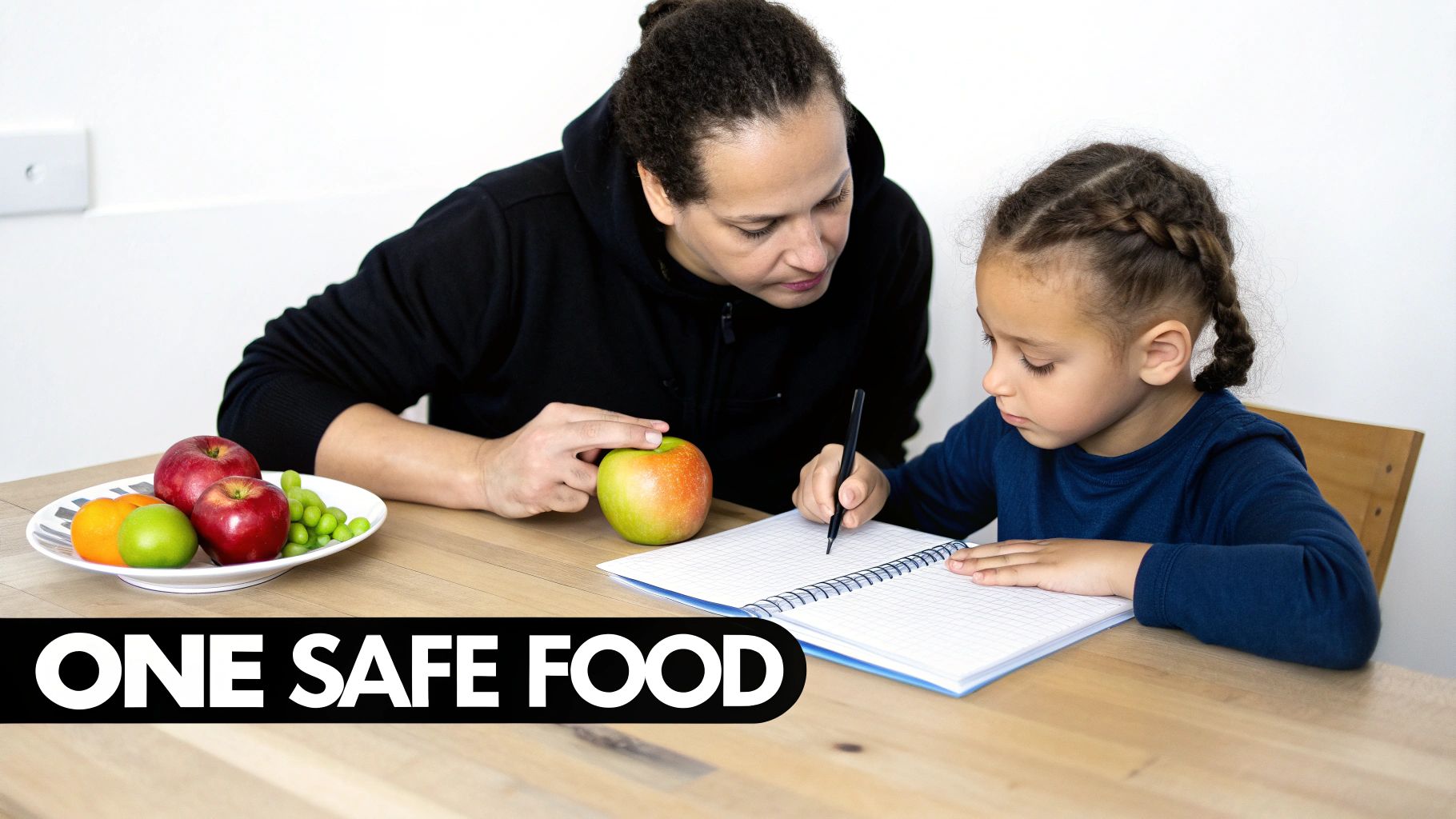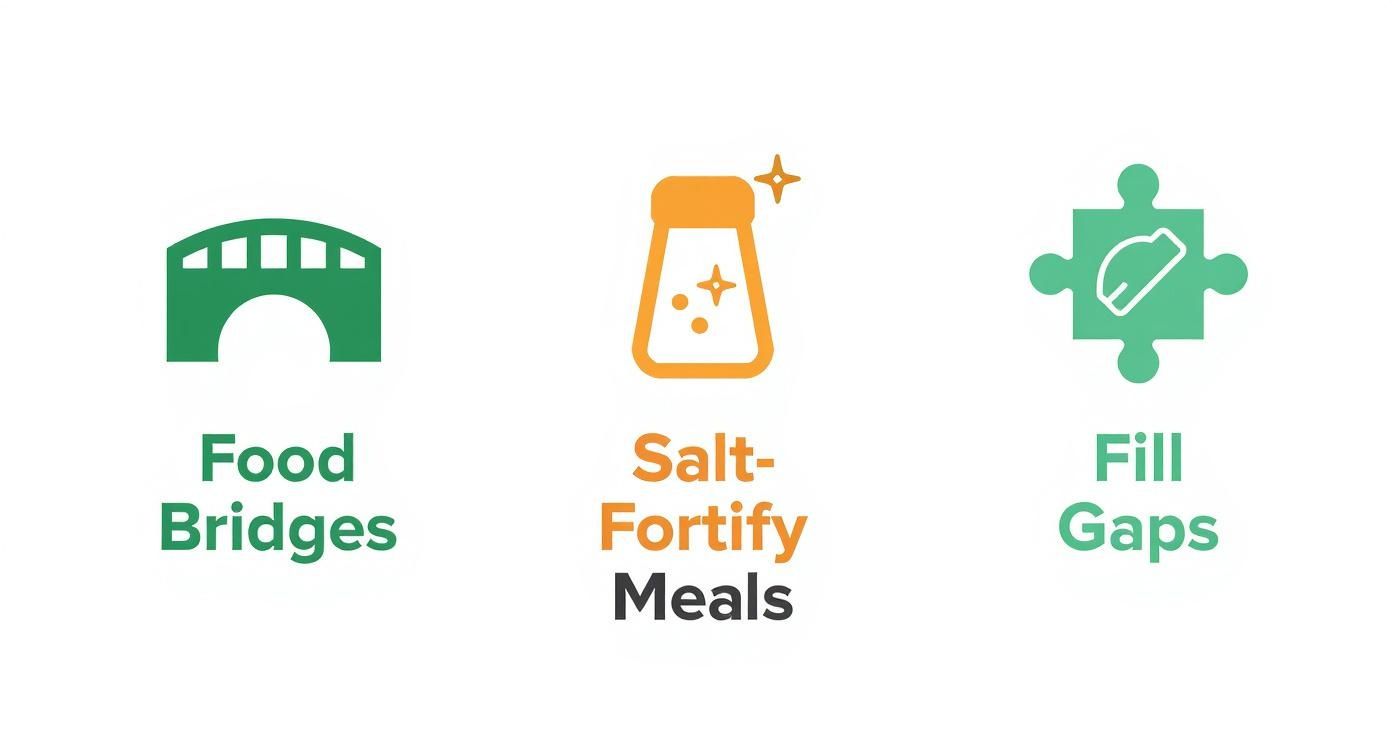Meal Planning for Picky Eaters Made Easy
If you're trying to crack the code on meal planning for picky eaters, the first step isn't about recipes—it's about empathy. Understanding why a child resists certain foods is the real starting point. More often than not, it has little to do with defiance and everything to do with developmental stages, sensory sensitivities, or even genetics. It's almost never the parent's fault.
When you reframe the challenge this way, you can start building genuinely positive mealtime experiences.
Why Your Child Is a Picky Eater (And Why It's Not Your Fault)

Before you even think about planning a week's worth of meals, let's get to the root of picky eating. While asserting independence can definitely be part of it, for many kids, food fussiness is a complicated mix of biology and development.
This insight can completely change your perspective. It helps you move from a place of frustration to one of compassion. Instead of gearing up for another mealtime battle, you can see your child for what they are: someone navigating a world of overwhelming smells, textures, and tastes. This simple shift is the foundation for creating a low-pressure environment where food is about connection, not conflict.
The Science Behind Food Fussiness
Picky eating isn't just a random quirk; there's real science behind it. Getting a handle on these biological and psychological drivers can demystify your child's behavior at the dinner table and give you better tools to respond.
Here are a few of the key factors that are often at play:
- Developmental Phases: Have a toddler? You're likely in the "neophobic" stage, where a fear of new foods is totally normal. This is an old evolutionary instinct kicking in—it was designed to keep newly mobile little humans from eating poisonous berries.
- Sensory Sensitivities: Some kids are born "supertasters," meaning they experience flavors like bitterness far more intensely than others. For others, it’s all about texture. Slimy mushrooms, mushy bananas, or even extra-crunchy crackers can be genuinely unpleasant for them.
- Genetics: You might be surprised to learn how much of this is inherited. A landmark UK study found that genetics can account for over 74% of the variation in food fussiness between the ages of 3 and 13. This means a child's natural predisposition can limit how effective even the best-laid plans are.
It can take up to 15–20 exposures before a child might accept a new food. An "exposure" doesn't just mean eating it. It can be seeing it on your plate, helping you wash it, or just touching it on their own plate—all without any pressure to take a bite.
Moving from Conflict to Connection
So much of this comes down to the emotional side of eating. A child’s refusal might be rooted in anxiety or a simple need for control, not just a dislike of broccoli. Deepening your understanding by teaching kids about their feelings can work wonders for mealtime dynamics.
When you acknowledge their feelings and understand the biological reasons for their choices, you can finally turn mealtime from a major source of stress into a moment for positive connection.
Building Your Meal Planning Foundation for Fussy Eaters

Alright, you've got a handle on why your child might be pushing that broccoli away. Now, let’s get practical and build a plan that actually works. Winning at mealtime with a picky eater isn’t about discovering one perfect, magical recipe. It’s all about creating a steady, low-pressure system that sparks curiosity instead of starting a standoff.
This foundation is built on a few core ideas that shift the dinner table dynamic. We're moving away from focusing on what your child won't eat and toward what they could learn to enjoy. The goal here is to stop being a short-order cook. You don't need to make two separate dinners every night. Instead, these strategies will help you put together smart, family-friendly meals where everyone has something they can happily eat.
Adopt the "One Safe Food" Rule
If you only take one piece of advice from this guide, make it this one. The "one safe food" rule is the single most powerful tool for dialing down mealtime anxiety—for both of you. It’s simple: every single meal you serve should include at least one thing on the plate you know your child likes and will eat.
This "safe" food doesn't need to be fancy. It can be as simple as a scoop of plain rice, a few apple slices, a dinner roll, or a side of their favorite fruit. Just having it there is a guarantee they won’t go hungry, which instantly removes the pressure to try the "scary" new stuff on the plate.
Once a child spots a familiar, trusted food, their nervous system gets the "all-clear" signal. Their guard comes down, making them more open to the other foods on the plate, even if they don’t take a bite right away.
This one small move shows them you get it. You're respecting their needs while still including them in the family meal, which lays the groundwork for more adventurous eating down the road.
Involve Them in the Process
Let's be real: kids are way more likely to try something they had a hand in making. Giving them a sense of ownership over meals can be a total game-changer. This doesn't mean you're handing over the reins and letting them build a weekly menu of chicken nuggets and mac and cheese.
It's about giving them structured choices that make them feel empowered. Here’s how you can do it:
- Look at recipes together. Flip through a cookbook or scroll through a recipe site with them. Let them pick out one or two meals for the upcoming week.
- Make the shopping list a team effort. Ask for their input. What kind of fruit should we get for snacks? Should we buy the fun spiral pasta or the little shells this week?
- Give them a mission at the grocery store. Turn it into a game. Task them with finding the brightest red bell peppers or picking out the perfect bunch of bananas.
These little jobs make food feel less like something being forced on them and more like a fun project you're doing together. If you want a quick way to find new ideas, a digital meal plan generator can help you and your child discover recipes that work for everyone.
Build a Consistent Meal Schedule
The all-day grazer is a picky eater’s best friend and a parent’s worst enemy at dinnertime. If a child has been snacking constantly, they simply won't be hungry enough to feel brave about trying something new.
A reliable meal and snack schedule is key to regulating their natural hunger cues. Try to offer meals and snacks around the same time each day, leaving about 2-3 hours between each one. It also helps to limit drinks like milk or juice between meals, as they can fill up little tummies. A predictable routine provides the structure you need for successful meal planning for picky eaters.
Crafting Nutrient-Packed Meals They'll Actually Eat
Let's be real for a second. The biggest stressor with a picky eater isn't the nightly dinner table standoff—it's wondering if they're getting the nutrition they need to grow. The good news? With a little smart planning, you can make every single bite count, even on the days when there aren't many bites to be had.
The secret isn't about forcing them to eat broccoli. It’s all about focusing on nutrient density and making clever additions to the foods they already like. Your goal is to gently, almost secretly, up the nutritional ante of their accepted meals.
Build "Food Bridges" to New Flavors
One of the most powerful techniques I've seen work time and time again is what I call "food bridging." This is where you introduce a new food that's incredibly similar in taste, texture, or even just appearance to something they already love. It’s a simple concept, but it works because it lowers the "fear factor" and makes the new food feel way less intimidating.
Think of it as taking tiny, baby steps from the familiar to the new:
- From Brand to Homemade: If they're devoted to one specific brand of chicken nuggets, try making your own baked version at home. They'll look almost the same, but you get to control every single ingredient.
- Smooth Texture Transitions: Love smooth, creamy yogurt? The next logical step is a silky-smooth fruit smoothie. Once that's a hit, you can try making it a little thicker or adding some blended-in seeds.
- Flavor Familiarity: If plain pasta is their go-to safe food, don't jump straight to a complex bolognese sauce. A much smaller step would be that same pasta with a tiny bit of melted butter and a light sprinkle of parmesan cheese.
This whole approach is about respecting their comfort zone while gently nudging the boundaries outward.
Fortify Their Favorite Meals
While you're slowly building those food bridges, you can also "fortify" the meals they're already eating without a fuss. This is your stealth-health strategy for boosting nutrition without a fight. The trick is to use ingredients that blend in so well they don't change the taste or texture in a noticeable way.
A 2019 analysis confirmed what many parents already suspected: picky eaters often don't get enough fruits and veggies, which can lead to lower intakes of crucial nutrients like iron and zinc. Fortifying their go-to meals is a fantastic way to help close those common nutritional gaps. You can dive deeper into the full research on picky eating and nutrient intake if you're interested.
Here are a few of my favorite, battle-tested tricks:
- White Beans in Sauces: Blend a can of rinsed cannellini beans right into your tomato sauce. I promise, they vanish completely, adding a great punch of protein and fiber.
- Seeds in Smoothies: A tablespoon of hemp hearts or chia seeds mixes into any fruit smoothie, adding healthy omega-3s and protein without a hint of flavor change.
- Hidden Veggie Purees: Finely pureed carrots, sweet potatoes, or even zucchini can be stirred into things like mac and cheese, meatballs, or meatloaf.
Pro Tip: When you start fortifying, start small. The first time, add just a tiny amount. You can gradually increase it in future meals. This prevents them from noticing a sudden change and deciding a previously "safe" food is now off-limits.
A great way to boost nutrition is by making simple swaps in the foods they already enjoy. Here’s a quick-glance table with some easy ideas to get you started.
Nutrient-Boosting Swaps for Common Kid Foods
| Original Food | Nutrient-Boosted Version | Key Nutrients Added |
|---|---|---|
| White Bread Sandwich | Whole Wheat Bread Sandwich | Fiber, B Vitamins |
| Sugary Cereal | Plain Greek Yogurt with Berries | Protein, Probiotics, Antioxidants |
| French Fries | Baked Sweet Potato Fries | Vitamin A, Fiber |
| Mac & Cheese (Boxed) | Mac & Cheese with Pureed Butternut Squash | Vitamin A, Fiber, Vitamin C |
| Plain Pasta | Lentil or Chickpea Pasta | Protein, Fiber, Iron |
These small changes can make a huge difference over time without causing a mealtime meltdown.
Having a solid plan is truly your best defense. By combining the food bridging technique with meal fortification, you're tackling the problem from two angles. You're supporting their immediate nutritional needs while also helping them develop a more adventurous palate for the long run. For more help putting this all together, take a look at our guide for creating a balanced weekly meal plan.
A Realistic Weekly Meal Plan Template
Theory is great, but seeing how these strategies play out in a real kitchen is where the magic happens. Let's walk through a flexible meal plan template you can adapt for your own family. The whole point is to build around the 'safe' foods your child already trusts while gently weaving in new things to try, completely pressure-free.
Forget rigid, stressful schedules. Think of this as a loose framework to lighten your mental load and bring some predictability back to mealtimes. The plan should serve you, not the other way around.
Empowering Kids with Choices
One of the biggest wins I've seen in meal planning for picky eaters is giving kids a bit of control. Interactive, build-your-own style meals are absolute gold for this. They get to assemble a plate they feel good about from a selection of parent-approved options.
Here are a few weekly staples that work wonders:
- Taco Night (Deconstructed): Lay everything out separately—seasoned ground turkey or beef, shredded cheese, mild salsa, chopped lettuce, and soft or hard tortillas. Everyone builds their own.
- DIY Pizza Friday: Use pita bread, English muffins, or even naan as a base. Set out bowls of sauce, cheese, and maybe some finely diced bell peppers or mushrooms for them to try.
- Build-a-Pasta-Bowl: Serve cooked pasta with separate bowls of plain tomato sauce, meatballs (or a plant-based alternative), steamed peas, and grated parmesan cheese.
- Bento Box Lunches: This is perfect for customization. Pack a 'safe' sandwich or crackers, then add cheese cubes, sliced cucumbers, and a small portion of a new fruit to explore on their own terms.
This approach is all about creating positive, low-stress food experiences.

As the visual above shows, it's about combining different tactics—like food bridging and fortifying meals—to make sure they're getting what they need while you work on expanding their palate.
Example 3-Day Meal Rotation for Picky Eaters
To give you a clearer picture, here’s a sample rotation. The key is that every single meal includes at least one familiar, accepted component. This isn't about forcing new foods; it's about providing safe, repeated exposure alongside foods they already love.
| Meal | Day 1 Example | Day 2 Example | Day 3 Example |
|---|---|---|---|
| Breakfast | Oatmeal with a side of their favorite berries. | Scrambled eggs with a piece of toast and butter. | Greek yogurt with a tiny sprinkle of granola to try. |
| Lunch | Deconstructed lunch: turkey slices, cheese cubes, whole-grain crackers, and apple slices. | Leftover DIY pizza with a side of carrot sticks and hummus. | A simple quesadilla with a side of black beans and corn. |
| Dinner | Baked chicken nuggets (safe food) with roasted sweet potato fries (new exposure) and steamed green beans. | Pasta with a familiar sauce and a small side salad for exposure. | Build-your-own taco bowls with all components served separately. |
This table just shows a possibility. The real goal is to create a rhythm that works for your family's unique tastes and schedule.
The most important part of any template is flexibility. If Tuesday’s plan doesn’t work out, don’t stress. The goal is progress, not perfection. You can always swap days or fall back on a super-simple "safe" meal if needed.
Having a routine helps your child know what to expect, which can dramatically lower anxiety around food. If you're looking for more personalized ideas, you might want to check out a customizable weekly meal planner that can help generate recipes based on your family's specific preferences.
Navigating Setbacks and Common Challenges
Let's be real: even with the best meal plan in the world, you're going to hit some bumps. One day they love broccoli, the next it’s their mortal enemy. A perfectly planned dinner is met with a full-blown tantrum. A birthday party completely derails your routine.
This isn't just normal; it's expected. The goal isn’t to create a perfect, setback-free eating journey. It's about learning how to handle these moments without losing your cool (or your mind).
Think of it as building resilience into your mealtime routine. You stick to your core strategies, like always having one "safe" food on the plate, but you don't let one bad meal feel like a complete failure. Remember, this is a marathon, not a sprint.
When They Flat-Out Refuse a Meal
It’s a scene every parent knows well. You place the meal on the table, and your child immediately crosses their arms, shakes their head, and declares they're not eating. It's so easy to fall into a power struggle here.
The single most important thing you can do is stay calm. Don't beg, bribe, or negotiate.
Just state the facts in a neutral tone. Something like, "This is what's for dinner tonight. You don't have to eat it, but we won't be having anything else." This simple approach takes the pressure off everyone and gives the choice back to them. And because you’ve included a safe food, you know they won’t go hungry.
Your mantra should be: The parent provides, the child decides. Your job is to offer a variety of foods at regular mealtimes. Their job is to decide if they eat and how much. This division of responsibility is a game-changer for reducing mealtime stress.
Handling Food Jags and Outside Events
Another classic challenge is the dreaded food jag. This is when your child will only eat one specific food—and nothing else—for days or even weeks. It’s incredibly tempting to just give in for the sake of peace and quiet.
A better approach is to serve a small portion of their current favorite alongside the rest of the family's meal. This way, they're still getting the comfort of their go-to food, but you're not giving up on offering variety.
Eating outside the home can also feel like navigating a minefield. Whether it's a restaurant or a friend's party, a little prep can make all the difference.
- Preview the menu: Before heading to a restaurant, pull up the menu online. Look it over with your child and see if you can spot a familiar or "safe" option together.
- Pack a backup: There's no shame in bringing a trusted snack to a party. A simple container of crackers or fruit can supplement the pizza and cake, ensuring your child has something to eat.
- Focus on the social side: Try to shift the focus away from the food. Talk about how much fun it will be to see their friends or celebrate with family.
If you're feeling overwhelmed, know that you're not alone. Parental perception of picky eating ranges from 20% to 50% across the globe, and it can take 10 to 15 repeated exposures before a child even considers trying a new food.
For more persistent struggles, especially if eating challenges are impacting your child's ability to feed themselves, professional support can be invaluable. Exploring options like occupational therapy for daily living skills is a great next step. Reaching out to a pediatrician or a feeding specialist is a sign of strength, not a sign that you've failed.
Navigating the Day-to-Day Questions of Feeding a Picky Eater
Even with a solid plan, you're bound to have questions pop up during the week. That's completely normal. Let’s tackle some of the most common worries I hear from parents, so you can feel more confident handling those tricky mealtime moments.
Think of this as your go-to guide for those "what do I do now?" situations.
How Many Times Do I Have to Serve a New Food?
Honestly, this is a marathon, not a sprint. It can take 10-15 (or even more!) exposures before a child even considers trying something new. And an "exposure" doesn't just mean eating it.
It can be as simple as:
- Watching you enjoy the food.
- Helping you rinse the veggies or stir the pot.
- Just having the food on their plate, no strings attached.
This is exactly why meal planning for picky eaters is so effective—it builds in those repeated, low-pressure chances. So when that piece of broccoli sits untouched for the tenth time, don't lose hope. Just having it there is a small win.
Am I Supposed to Make a Separate "Kid Meal"?
My best advice? Try to avoid becoming a short-order cook. It’s an easy trap to fall into, but making a whole separate meal can actually make picky eating habits stick around for longer. It sends a signal that if they hold out, their special request will always be granted.
Instead, lean on the "one safe food" rule.
At every meal, make sure there’s at least one simple thing on the table you know your child will eat. This could be plain pasta, a piece of bread, or some apple slices.
This brilliant little trick removes the power struggle. You're serving one family meal, but they have a familiar food to fall back on so they won't go hungry. It respects their comfort zone while holding the gentle boundary that "this is what we're all having for dinner."
Is Hiding Vegetables in Their Food a Good Idea?
Hiding veggies is a great trick for a nutritional boost, but it’s not a complete solution on its own. While sneaking puréed spinach into a smoothie is a fantastic way to get some greens in, it doesn’t teach your child to actually like spinach.
I always suggest a two-part strategy. Go ahead and use hidden veggies as your nutritional safety net—it'll ease your mind knowing they're getting some goodness. But at the same time, keep serving those vegetables in their whole, recognizable form. This way, you get the best of both worlds: they're getting the nutrients they need while also getting the exposure that builds a future veggie-lover.
Ready to take the guesswork out of your weekly menu? AI Meal Planner creates personalized meal plans tailored to your family's needs, making it easier to incorporate safe foods and new exposures without the stress. Start building your custom meal plan today!
AI-powered nutrition
Get Your Personalized Meal Plan
AI creates the perfect meals for your goals, lifestyle, and taste.
Start Your Journej
